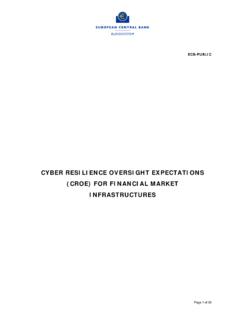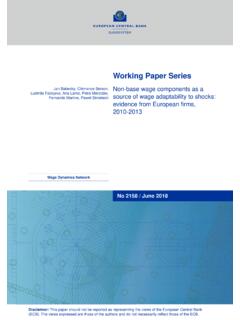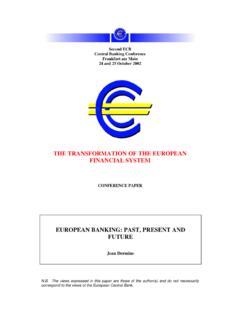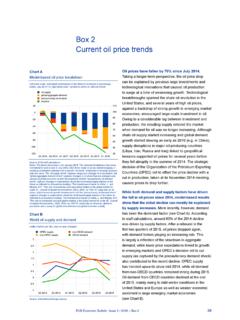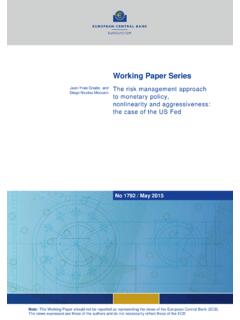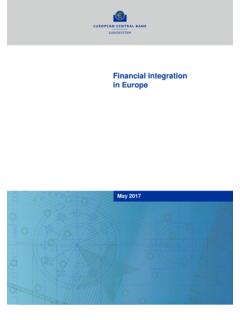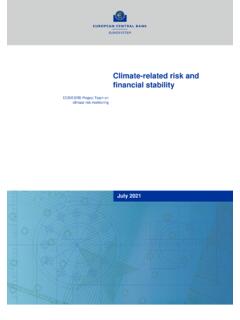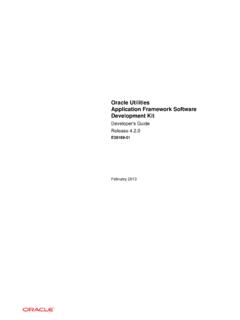Transcription of Report on a digital euro - European Central Bank
1 Report on a digital euro October 2020. Contents Foreword 2. Executive summary 3. 1 Introduction 6. 2 Reasons to issue a digital euro possible scenarios and implied requirements 9. Scenarios related to core Central bank functions 9. Scenarios related to the broader objectives of the EU 14. 3 Potential effects of a digital euro and implied requirements 16. 4 Legal considerations regarding a digital euro 24. 5 digital euro functional design possibilities 26. Key dimensions of functional specifications 26. Possible coexistence of types of digital euro 34. 6 Technical and organisational approaches to digital euro services 36.
2 Back-end infrastructure 36. End-user access solutions 41. Interfacing between digital euro users and the Central bank infrastructure 43. 7 Follow-up work 45. Operational considerations 45. Institutional framework 46. Annex 1: digital euro characteristics identified in the Report 48. Annex 2: The digital euro is not a crypto-asset or stablecoin' 50. Annex 3: Wholesale application of a distributed infrastructure 52. Report on a digital euro 1. Foreword A key part of the Eurosystem's mission is to provide citizens with riskless money for their payments; the Eurosystem has been providing euro banknotes for nearly two decades.
3 While cash is still the dominant means of payment, new technologies and the increasing demand for immediacy from consumers are changing the way European citizens pay. This is evident in the expanding role of fast electronic payments. To ensure that consumers continue to have unfettered access to Central bank money in a way that meets their needs in the digital age, the ECB's Governing Council decided to advance work on the possible issuance of a digital euro an electronic form of Central bank money accessible to all citizens and firms. A digital euro would be introduced alongside cash, it would not replace it.
4 A digital euro would create synergies with private payment solutions and contribute to a more innovative, competitive and resilient European payment system. By serving as a unifying force in Europe's digital economies, a digital euro would also be an emblem of the ongoing process of European integration. It is too early to commit to a specific design of a digital euro . But it is clear that any type of design must fulfil a number of principles and requirements identified in this Report . including accessibility, robustness, safety, efficiency and privacy while complying with relevant legislation. Issuing a digital euro would be relevant for nearly everything the Eurosystem does and it would have pervasive effects on society as a whole.
5 This Report will therefore form the basis for a dialogue with citizens and other external stakeholders. It will serve as a starting point for a public consultation in which we encourage everyone to participate. And together with the European Parliament and other European institutions and authorities, we will discuss the operational and legislative framework that would be necessary to introduce a digital euro . At the same time, experiments on the practical aspects of a digital euro are necessary to examine the strengths and weaknesses of different options. Looking ahead, we need to be ready to introduce a digital euro , shall the need arise.
6 For now we maintain the options open as to whether and when this should happen. Our role is to secure trust in money. This means making sure the euro is fit for the digital age. Christine Lagarde Fabio Panetta ECB President ECB Executive Board Member and Chair of the Eurosystem High-Level Task Force on Central Bank digital Currency (HLTF-CBDC). Report on a digital euro 2. Executive summary This Report examines the issuance of a Central bank digital currency (CBDC) the digital euro from the perspective of the Eurosystem. Such a digital euro would be a Central bank liability offered in digital form for use by citizens and businesses for their retail payments.
7 It would complement the current offering of cash and wholesale Central bank deposits. The possible advantages of a digital euro and the rapid changes in the retail payment landscape imply that the Eurosystem needs to be equipped to issue it in the future. A. digital euro could support the Eurosystem's objectives by providing citizens with access to a safe form of money in the fast-changing digital world. This would support Europe's drive towards continued innovation. It would also contribute to its strategic autonomy by providing an alternative to foreign payment providers for fast and efficient payments in Europe and beyond.
8 A digital euro may even become essential in a number of possible scenarios. For example, if the use of cash were to decline significantly, other electronic payment methods were to become unavailable owing to extreme events, or foreign digital money were to largely displace existing means of payment. In the absence of a digital euro , the Eurosystem would need to identify alternative tools to respond to the possible materialisation of one or more of these scenarios. For example, a decline in the use of cash as a means of payment could exacerbate financial exclusion for the unbanked and for vulnerable groups in our society, forcing the Central bank to intervene.
9 The introduction of a digital euro could address multiple scenarios at once, but it would have profound implications for key areas of Central banking, for the broader economic and financial system, and, ultimately, for the life of European citizens. A digital euro would also support other strategic objectives of the Eurosystem. It could provide state-of-the-art payment services that reflect people's changing needs and actively promote innovation in the field of retail payments, complementing private payment solutions. It could increase choice, competition and accessibility with regard to digital payments, supporting financial inclusion.
10 A possible role for the digital euro as a tool to strengthen monetary policy is not identified in this Report , but could emerge in the future on the basis of further analysis or owing to developments in the international financial system. Finally, the digital euro could represent an option for reducing the overall costs and ecological footprint of the monetary and payment systems. The Eurosystem would design the digital euro in such a way as to avoid possible undesirable implications for the fulfilment of its mandate, for the financial industry and for the broader economy. Some digital euro design options could affect the intermediation function of banks and their funding costs, especially in situations of stress.
